How to crochet with variegated and self striping yarn
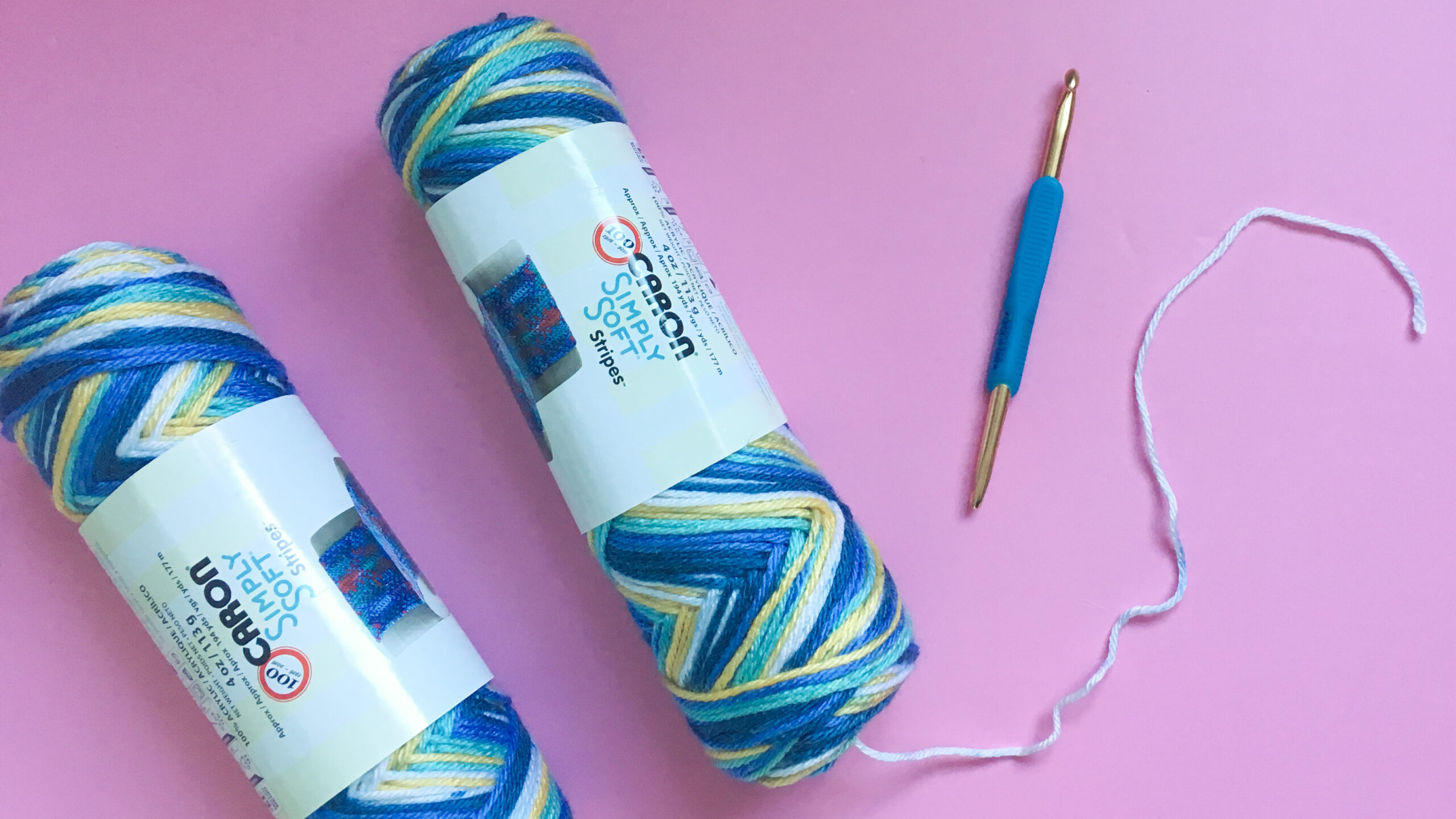
In this post, I will share my top tips for crocheting with variegated yarn and include a round up of 24 crochet patterns ideal for multi-coloured yarn.
This includes a run down of the different types of multicoloured or self-striping yarns available and the differences between them. The goal is to help you understand what aspects to consider when deciding what to crochet with variegated yarn.
Crocheting with multicoloured yarns can be such a simple way to create beautiful patterns without the need for complex colourwork. Choosing the right yarn for your project (or the right crochet project for your yarn) is the key to success.
This article shares a ton of crochet project ideas and examples, tips for crocheting with colour changing yarns. It finishes with a crochet pattern round up, sorted by project type, all of which are a great way to use different kinds of multicoloured yarn.

This post contains affiliate links. This means if you click a link to a product and go on to make a purchase, I receive a small percentage of the sale at no extra cost to you. You can read my full affiliate disclosure here. As an Amazon Associate I earn from qualifying purchases.
The different types of multi-colour yarns
There are many different names and terms when it comes to self-striping, variegated or gradient yarns.
A lot of these seem to be used interchangably, though often there are subtle, but important differences. Important when it comes to choosing a suitable crochet project for your yarn at least.
So I wanted to take a few moments at the start to share my definitions and understanding of the differences.
What is variegated or multi-coloured yarn?
Variegated yarn is a hank, ball or skein of yarn containing more than one colour.
The colour changes can be gradual or immediate, and are usually repeated consistently throughout the length of the ball. However, with hand dyed and some speciality yarns, there is likely to be more variation in the colour distribution.
Variegated yarn is a bit of an umbrella term for yarns containing multiple colours and there are many different styles in this type of yarn.
You can have long or short (slow or fast) colour changes, speckles, splashes, flashes or sprinkles, all of which will create a huge variation in what the finished yarn looks like when wound and when crocheted with.
A heavily variegated yarn (as seen in the image below) will have lots of short colour changes, maybe speckles which create a tweed effect too.

A gently, or lightly variegated, yarn will have fewer, longer and perhaps more subtle colour changes.
Self-striping yarns
Self striping yarns are a type of variegated yarn with relatively long lengths of colour which creat stripes in your fabric. Chroma worsted from We Crochet, as shown below, is a soft self striping roving yarn with medium length colour changes.

I find the colour changes in self striping yarns tends to be fairly abrupt. The recent explosion in the popularity of yarn cakes, started with the Caron Cake yarn craze a few years back and has resulted in the rise in choice of self striping yarns.
When worked in a consistent stitch pattern, variegated yarns ‘pool’ to create a colour pattern in your crochet fabric.
What is colour pooling?
Colour pooling, or yarn pooling, is the pattern that multicoloured yarn makes in the fabric when it’s crocheted (or knitted) up.
Depending on the size of your project and the length of the colour changes, yarn will pool differently.
One kind or pattern you can get from yarn pooling is called ‘colour flashing’ where the yarn creates a kind of jagged, zig zag pattern. This can be desired and intentional, or not; It can look awesome or, frankly, a hot mess!
Generally if you are crocheting something with no shaping, using the same stitch pattern and consistent tension, then your pooling is likely to create a consistent colour pattern. Whether you like that pattern or not is both a matter of taste and pot luck. (Or complicated calculations based on the length of the colour changes and stitch length perhaps?)
What is planned pooling?
Planned pooling is where you intentionally set up a project so the self-striping yarn pools to make a specific pattern. This tends to use self striping yarns with colour changes in the medium length range. Around 3 metres per colour change seems to be a good place to start.
You can buy some self-patterning yarns specifically designed for planned pooling, but many variegated yarns will work.
Planned pooling can create some incredible checked and tartan style patterns; It’s a beauty to behold when done right, but a bit of an eyesore when not.
If you’re really curious, there’s a whole thread on Reddit dedicated to it: R/planned_pooling. (I’m starting to enjoy all the fibre arts Reddit groups these days – they are super helpful if you’re ever stuck on anything.)
Gradient and Ombré yarns
Like variegated yarns, ‘gradient’ yarns also include more than one colour but the colours change slowly throughout the ball (or often cake) of yarn.
These yarns, sometimes also called graduated yarns, may include complementary or contrasting colours or different shades or tones of the same colour.
Below is a sneak peek of a WiP of mine using a ‘block’ graduated yarn cake which is plied rather than twisted. I purchased this cake from Crochet UK who offer the option to customise your colours!
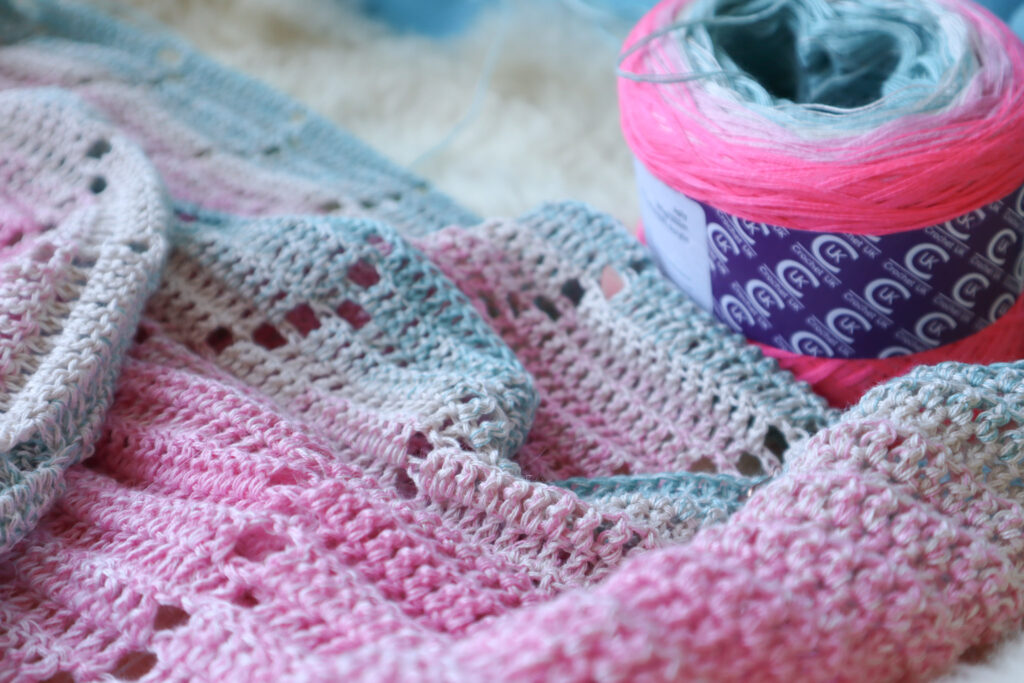
Ombre yarns are a form of gradient yarn where the colour changes are made up of different tones from within a single colour. Sheepjes Whirl used in the Crochet Del Mar Shawl (featured in the round up at the end) uses an ombre gradient yarn.
Generally because of the long slow colour changes, this colour transitioning yarn is suited to larger projects so you can see the beautiful colour changes over a larger area.
Graduated yarn cakes are very popular for circular mandalas or centre out blankets because of the beautiful drama they often create.
They are also perfect yarns for large shawls (indeed some are specifically sold as shawl yarns).
You can get gradient yarns with shorter colour changes, such as some sock yarns, which can work over smaller areas. In the picture below, you can see the yarn I used for the Step on Socks was a graduated yarn where the colours changed ply by ply.

The specific yarn has now been discontinued but I wanted to share this image as it shows how the plys of yarn change one at a time as it transitions from one colour to another, creating an almost stripy effect in the yarn strand and a kind of specked effect in the heel of the sock.
Another way to work with these yarns over one project is to ‘mirror’ two traditional gradient cakes. Simply start one from the inside, and when you come to join the second, start it from the outside. The Block rocking corner to corner poncho uses this method.
Which reminds me that gradient yarns look awesome when worked on the diagonal too. If you’re not familliar with the classic corner to corner stitch, do check it out here.
Variegated yarns with short colour changes
As previously mentioned, these are sometimes called heavily or highly variegated yarns.
Yarns with short colour regular colour changes have a tendency to pool very easily, which can be both a strength and weakness in my experience.
I would always start by swatching with this kind of yarn. Because the colour changes are so short, a standard crochet swatch will show you how they will pool.
I went digging around in my magical bag of swatches to see what I could find and came across these two somewhat crumpled swatches both made in the same ‘paintbox chunky pots’ yarn.
The top one is just rows of half double crochet (which is starting to unravel) and the second is a classic granny square, though it’s kind of hard to recognise it as such at first.
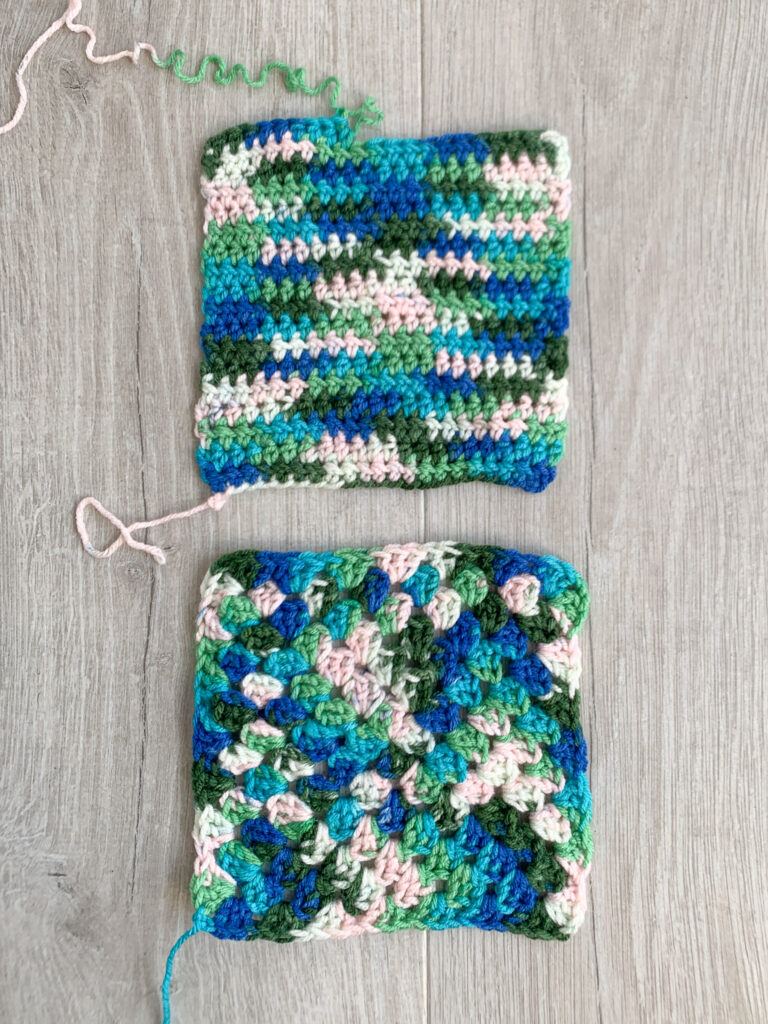
This illustrates pretty well how differently the same yarn can look in a different project.
Note that, for longer colour changes, your swatch would need to be more representative of the size of the project to gain a real understanding of how the colours will form.
Personally, I am very cautious about choosing heavily variegated yarns for crochet projects unless I love how the different colours smush together (not a technical term).
I used a short colour changing yarn (the half used ball in the image below) for the Mighty Mitts remake recently and I love how those turned out.

The two colour ways above are from the Zandra Rhodes colour lab collaboration with West Yorkshire Spinners. The unopened ball has short to medium length colour changes and will create some pretty stripes in a small project like a scarf. The opened ball has much shorter colour changes and created a more dappled, pooled pattern.
Semi-solid yarns
Although strictly speaking, semi-solid yarns do not include multiple colours, I have included them here because of the effect that can be created from these tonal beauties.
A semi-solid yarn typically features the same colour with varying intensity throughout the ball.
The undulations in the tone may be regular or inconsistent, depending on the way the yarn was dyed. This is a great way to add texture to simple crochet stitch patterns.
Semi-solids seem to often be hand dyed. Indeed my efforts to dye some natural yarn with nettles from my garden resulted in a rather lovely semi solid green (which later became the version of the my brother’s beanie hat that I used for the photo tutorial).

Below is a much better example of some hand dyed semi solid yarns, the ones used in the Rainbow Smiles Crochet Sweater Pattern. These gorgeous sparkly yarns came care of Eden Cottage Yarns.
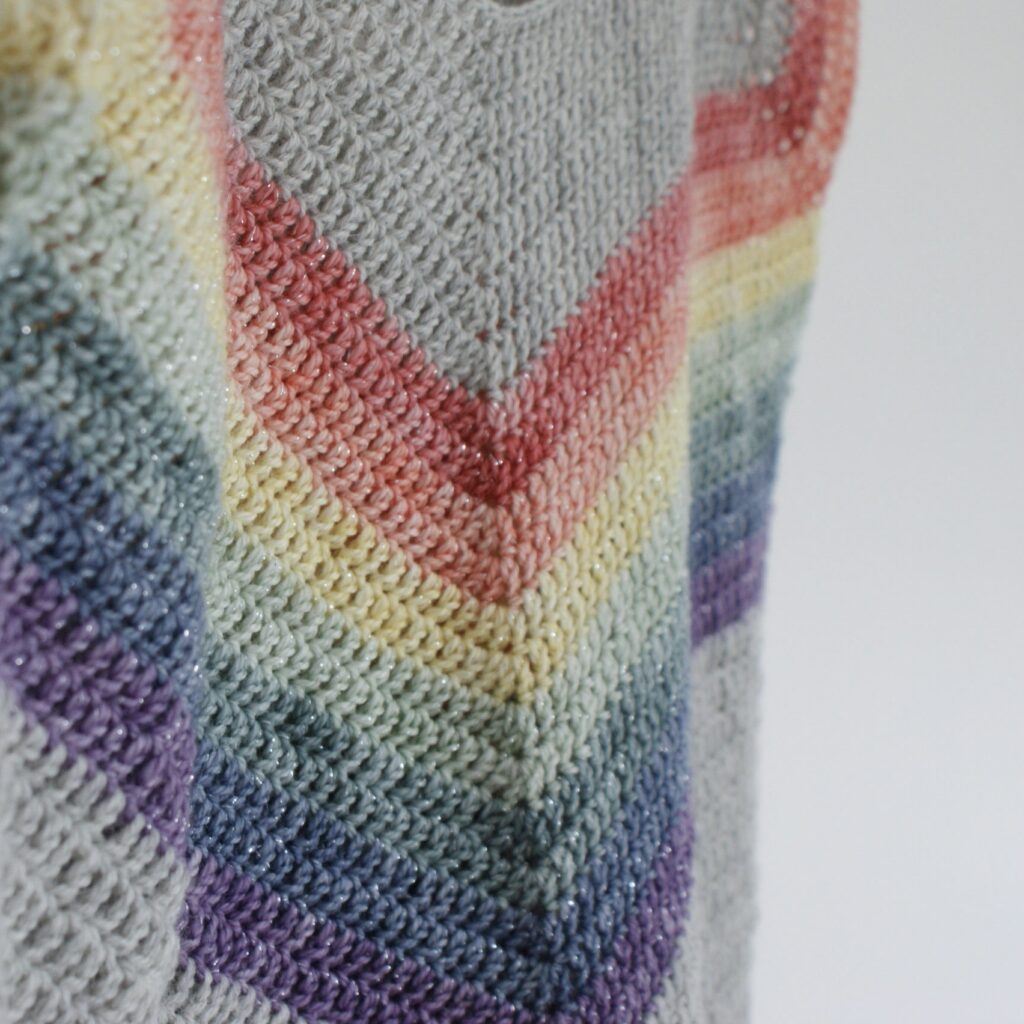
You can see how the colour intensity changes throughout the stripes, giving a heather effect. These were mini skeins which is a great, and more affordable way to introduce hand dyed yarns to your crochet projects.
Hand dyed yarn
Hand dyed yarns can be a law unto themselves when it comes to colour changes and can really open the creative floodgates.
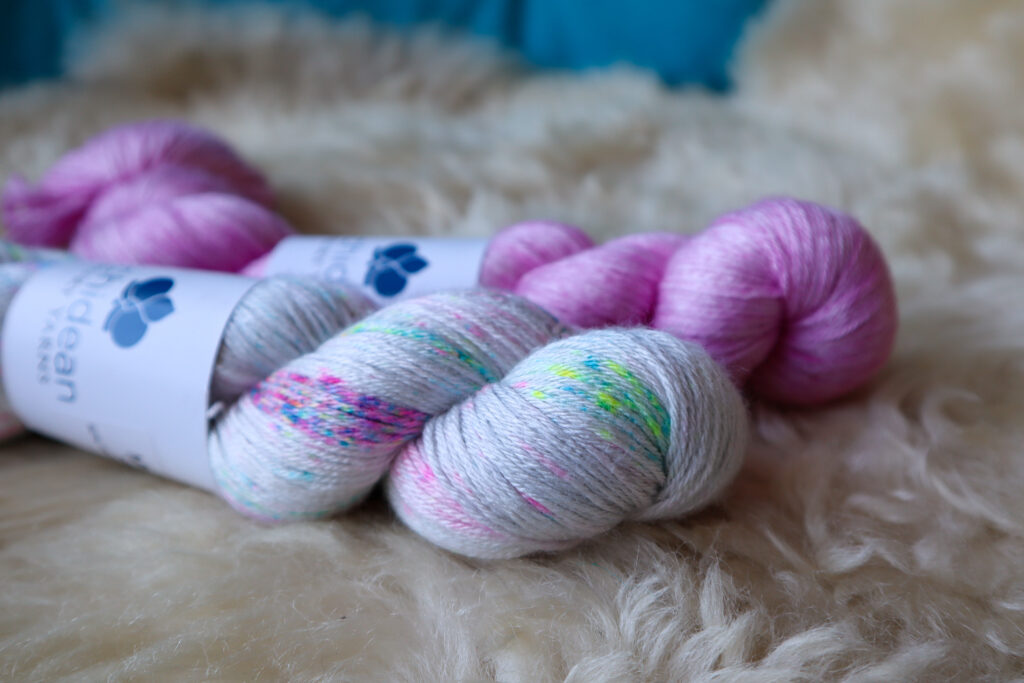
I love going to yarn festivals and looking at all the incredibly hand dyed yarns. However, I have learned, over the years, to remind myself that how they look in a skein is not representative of how they look in crochet fabric.
Many yarn dyers focus on knitters, and multi-coloured yarns can look very different knitted up versus crocheted. If you’re buying hand dyed yarn, check if there is a sample worked up with it. Ask specifically if they have a crochet sample. It’s more common to see squares knitted up, but when crocheted, even in a simple single crochet square, the fabric can look very different.
Even with a crochet sample, remember that different crochet stitches will also look different in the same yarn.
My preference with hand-dyed yarn is to go for something that has a bulk of a single colour with occasional splashes of different colours, rather than something that’s heavily variegated and a bit of everything. It’s a good example of less is more.
The pink yarn below was used for the Corona Halter top and worked up beautifully (you can see it in the round up below as it’s a great example of how variegated yarns can be used in garments.

Assigned pooling yarn / Zip and Zebra yarns
‘Zip dying’ creates is a yarn which has a highly contrasting repeating flash of colour (or colours) in just a small area of the otherwise solid coloured hank.
You can get some incredible versions of assigned pooling yarn from The Wool Kitchen, amongst other dyers.
Below you can see the ‘long zip’ skein I used in The Lotus Pool shawl pattern which uses assigned pooling yarn to create a floral water-scape.

Other assigned pooling yarns will have shorter zip sections to create a flash of colour in your crochet project.
I’ve also seen a rise in Zebra yarns which have a black and white plied section which interchanges with solid colours. I used such a yarn, hand dyed with black and neutral colours, in the one of the 4 ply samples of the Fisherman’s Winter crochet hat pattern. (Below.).
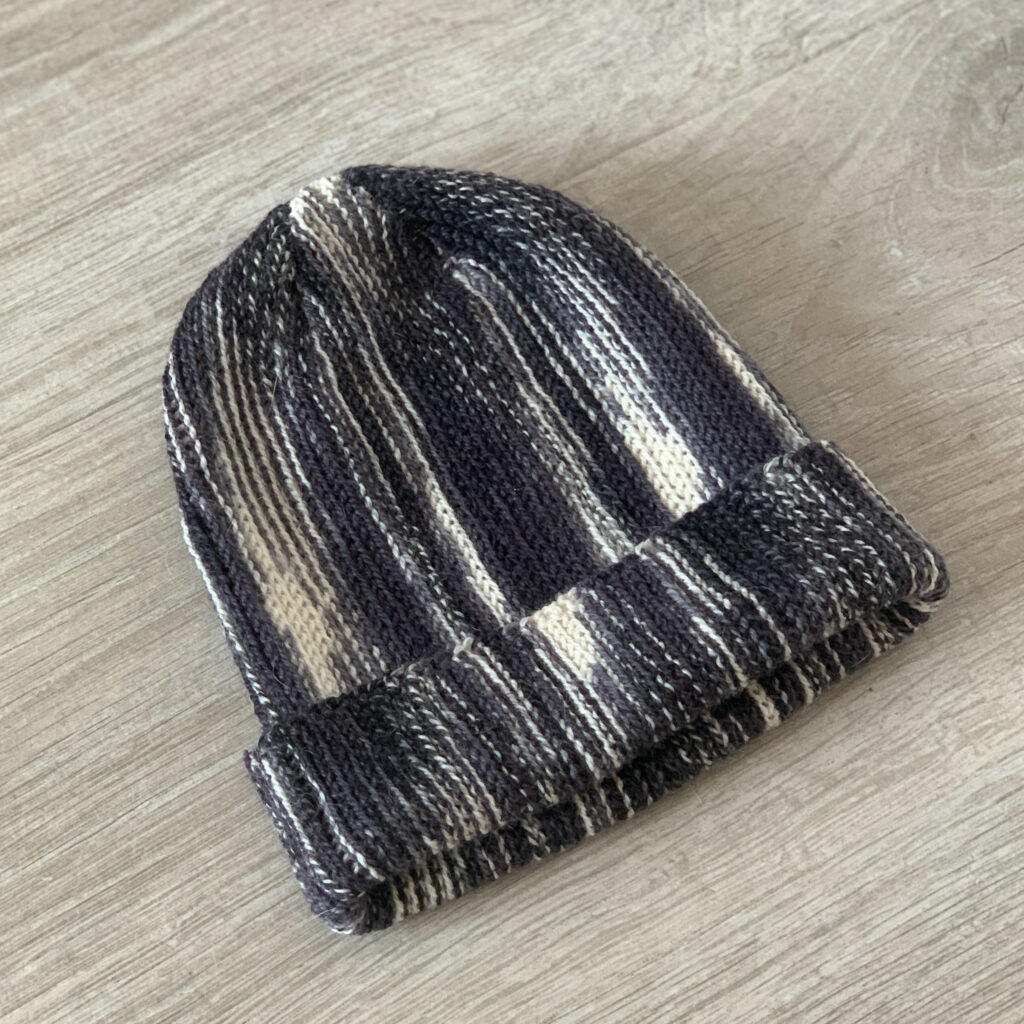
This version of the crochet hat reminds me of the matrix for some reason.
Tips for crocheting with variegated yarns
Now you’ve had a good wander through all the different types of multi-coloured yarns there are to choose from, I want to share some tips for working with them.
Although there are no hard and fast rules about where multicoloured yarns work and where they don’t, below I’ve share what you’ll want to think about when matching a crochet project with a variegated yarn.
Length of colour the change
The first thing to consider is how long the colour changes are, particularly in relation to the size of your project and the complexity of the crochet stitch pattern you’re using.
Longer colour changes work well with larger projects and can look really effective with complex stitch patterns as well as simple ones.
Short colour changes or heavily variegated types of yarn can work well over small or large projects, but tend to do better with simple stitch patterns.
Stitch Selection
Choosing the right stitch for your yarn is vital to get a result you’re happy with. (Remember the swatch image from up top and how different the two pieces came out with different stitches?)
For yarns with short changes, let the yarn do the talking and keep you stitches simple. The stitch texture can get lost when you have tons of colours so keep it simple.
You want the stitch pattern to work in harmony with the colours in the yarn, not to try and shout over one another and create something that just confusing to look at. This is probably one of the biggest mistakes I see when people work with variegated yarns, espeicially with shorter changes.
If in doubt, keep it simple!
If you want to use complex or textured crochet stitch patterns, you will have more success when crocheting with yarns with longer colour changes.
The shifting sands Jasmine stitch snood below is an example of where they can work.

This one is a real yarn eater of a stitch, so I wouldn’t work with anything with shorter colour changes. (Unless you could get a colour change exactly the length of each jasmine stitch, that would look pretty awesome!)
Crochet project construction
Think about how your yarn will work with the construction of the item you’re working on.
For example, if you have an ombré yarn with a gradual colour change and want to make a sweater with a consistent fade, you’ll need to do some advance planning.
You could make a top down seamless garment and the body would look great, but then when you come to add the sleeves, you’re going to loose the fade effect unless you switch to new balls and start where you left off. It’s possible, particularly with smaller balls or shorter changes, but requires quite a lot of planning.
Perhaps save your big cake for something sleeveless or a garment made in one piece like the slow living skirt.
‘Reading your yarn’ and swatching
Reading your yarn is great term I heard which, to me explains the skill that comes with time and experience, where you can start to imagine how a yarn will look worked up.
It’s essentially the result of combining the knowledge and tips I’ve shared here, plus practice. Lots of practice.
I’ve made a lot of bad choices over the years with variegated yarn to help me know what the right choices are, and I still don’t always get it right. If you’re new to working with multicolour yarn and have a project in mind, make a swatch to see how it crochets up.
Failing that, look up the yarn somewhere like Ravelry so you can see what other people have done with it. This is a great way to learn and get inspired with minimal effort. You can use their advanced search to look at projects by yarn.
Mixing multi colour yarns with solid yarns
If a multi-colour yarn feels too busy or too much for your project, alternating it with a solid colour is a great way to get the most out of it.
The swatch below has the colour lab yarn I shared above mixed with a solid blue colour of the same yarn. The coloured section is super busy, it reminds me of fruit salad sweets, but the solid colour helps to both calm and highlight the colour section. I love how this looks. It would look fabulous as a feature strip in a hat or across the front of a sweater for example.

If you find something like this still too busy, holding a solid colour together with a variegated yarn could be a way to mitigate any negative effects of unsightly colour pooling. It will create more of a marled effect and maybe tone down the noise.
Using variegated yarns with medium length colour changes for sweater yokes is a great hack to achieve an easy colour work effect. Check out the double knit sample of the Any yarn will do sweater as an example.

The colours mixed with the charcoal create a really effective contrast and make the sweater look much more intricate than it actually is.
I hope you’ve found all of those tips useful. It’s a lot to get through I know, but it’s really worth getting to grips with this stuff to set yourself up for success.
You’ve earned a rest from all the theory now, so lets get to the easy bit and check out some crochet patterns suggestions for you.
24 crochet patterns using colour-changing, variegated yarns
Below is a round up of crochet patterns I’ve chosen for you which use variegated yarns of different styles.
I have grouped them by project type from smallest to largest, and for each pattern have given the name of the pattern (linked), the style of yarn the sample uses and the name of the yarn (where available). I’ve also added some suggestions and thoughts each pattern.
This crochet pattern round up includes crochet projects for all skill levels. One of the great things about crocheting with variegated yarn is that you can make very simple projects look more intricate than they actually are.
Crochet socks and variegated yarn
Socks are a great way to use multi-colour yarn in crochet. You can go to town with colour because it’s such a small, condensed item.
If you want to tone it down, try working the cuff, toe and maybe heel in a contrasting solid colour (or vice versa).
1. Easy toe up crochet socks
Starting with my best selling crochet sock pattern. These are fun to make with any kind of variegated yarn. If you check out the pattern page, you will see them crocheted in Paintbox Yarns Sock, creating more speckled, earthy tones.
It looks like a different pattern because of the stark colour changes, but it’s all the same crochet stitches. A testament to how colour changes change the final look.
- Pattern name & designer: Step on Socks by Dora Does (i.e. me)
- Yarn style used: A graduated yarn with medium-long colour changes
- Yarn details : Picture shows a discontinued Hobbycraft graduated sock yarn
- Pattern status: Free in one size, paid PDF pattern version includes six sizes

Crochet gloves and wrist-warmer pattern using variegated yarn
Like socks, crochet gloves, mittens and writs warmers lend themselves well to most styles of variegated and self striping yarns
2. Fingerless gloves
Mighty mitts is simple textured crochet fingerless glove pattern. They break my rule about using texture with highly variegated yarns, but because it’s a simple back loop stitch I think it works pretty well.
This is also a classic example of colour pooling. This yarn creates fun pooled pattern. The pattern changes where there are increases versus where the glove is crocheted even which you can just about see if you look closely (between the wrist and base of the thumb).
- Pattern name & designer: Mighty Mitts (by me)
- Yarn style used: Variegated with short colour changes paired with a solid yarn for the cuffs
- Yarn details: West Yorkshire Spinners Colourlab DK, Zandra Rhodes’ Woodland Awakening and Standard colourlab DK in Harbour Blue
- Pattern status: Paid PDF

3. Self-striping crochet wrist warmers
I love these beginner friendly crochet wrist warmers. Rosina from Zeens and Roger is the queen of wrist warmers, mitts and fingerless gloves, and she hasn’t let us down with this simple, free crochet pattern.
I absolutely love the colours in this self striping yarn. They are are inspired by the London Tube system, hence the colourway name ‘mind the gap.’ I think that’s inspired and this yarn is firmly on my “want it” list.
- Pattern name & Designer: Self striping wrist warmers from Zeens & Roger
- Yarn style used: Self Striping hand dyed sock yarn
- Yarn details: Mind the gap yarn by Trailing Clouds on Etsy
- Pattern status: Free crochet pattern on blog

Crochet hat patterns using variegated yarn
Crochet hats are another small crochet project where there’s quite a lot of choice with the style of colour changing yarn you choose. A heavily variagated yarn could really pack a punch (with the option to add a solid colour brim or pom pom perhaps?), but a more gentle gradient or self-striping yarn would look great too.
4. Simple one skein ombré crochet hat
I love how delicate the fade is on this hat from the Loopy Lamb Crochet. The gentle colour transition works really well with those textured ribs.
This is what I meant about making sure the stitch pattern does not compete with the colour changes. It’s a great example of how to do it right.
This pattern uses Chroma worsted twist. I’ve worked with and loved the roving chroma worsted, so to learn that there is a twist version available has made me very happy!
- Pattern name & Designer: Into the fade, one skein crochet hat pattern from The Loopy Lamb
- Yarn style used: A two ply, worsted weight colour graduated yarn
- Yarn details: Chroma Twist Worsted from We Crochet
- Pattern status: Free pattern on blog

5. Multi-coloured toddler hats
These cute toddler hats have a lot going on and I love the almost patchwork feel the yarn creates in the horizontal ribs.
The pattern use a mix of solid and ‘print’ yarns. Print is a term which is often used by yarn brands to describe heavily variegated and splashed colourways of their solid yarn equivalents.
I also think that these hats would make great stashbusters for small amounts of left over multicolour yarns, mixed with a matching solid.
- Pattern name & Designer: North Shore Hat pattern from Stitching Together
- Yarn style used: A mix of variegated and solid yarns
- Yarn details: Premier everyday Print and Solid yarns
- Pattern status: Free pattern

6. Free filet crochet hat and scarf pattern
This way up hat and scarf set use a self striping yarn with long and gentle but short colour changes.
Filet crochet looks great with self striping and slow graduated yarns. If a yarn is too heavily variegated then the filet pattern can get lost so I wouldn’t suggest that as a yarn substitute.
- Pattern name & Designer: This way up filet crochet hat and scarf by Dora Does (me!)
- Yarn style used: Self-striping roving, worsted weight with a soft colour transition
- Yarn details: Chroma Worsted in shade ‘Sandpiper’
- Pattern status: Scarf pattern free on the blog with premium paid PDF including hat and chart

Crochet cowl and snood patterns using variegated yarn
Cowls and snoods need a little more consideration when pairing with colour changing yarn. Because they are often squished down when being worn, the pattern you see when they are laid flat may not quite translate when they are being worn.
Using long colour changes combining variegated with solid yarns is a great approach to managing this.
You can learn more about crochet cowls and snoods in this issue of my ‘all about crochet’ series.
7. Crochet cowl made with a sock set
This crochet cowl pattern was designed out of a challenge to make something that wasn’t socks from a sock set. A sock set includes a solid and a variegated skein of yarn, dyed to work together.
Here I have used the smaller semi-solid pink yarn to create wavy lines which breakup the more heavily but subtly variegated multi-colour yarn. I love the result and have gotten a ton of wear out of this beauty over the winter.
- Pattern name & Designer: Hidden Wavelengths crochet cowl by Dora Does
- Yarn style used: 4ply sock set; 100g variegated sock yarn plus 20g semi solid mini
- Yarn details: Hand dyed sock set from Pippin Yarns, Colourway ‘pops of pastel’
- Pattern status: Free on the blog with paid-ad free pdf available

8. Beautiful colourwork cowl
I love Brianna K’s designs as they are often so innovative in very subtle ways that make a big difference.
Choosing a self striping yarn for the lovely colour work in this cowl creates such an effective fade. It’s a really good example of creative and interesting ways to mix solid colours and variegated yarns.
- Pattern name & Designer: Boho Desert Cowl from Brianna K designs
- Yarn style used: Fingering weight self striping with a graduated colour change
- Yarn details: We Crochet Chroma fingering weight in shade ‘Vermont’ for the self striping yarn and Twill fingering weight in Horchata Heather for the solid colour
- Pattern status: Free crochet pattern on the blog with paid PDF available

Crochet scarf patterns using variegated yarn
Crochet scarves are great for variegated yarns of almost all styles. The are essentially just large rectangles (learn all about crochet scarves here).
Because there is usually minimal shaping, you won’t get shifts in pooled patterns, unless you change the stitch type. There is also the opportunity to mix up stitches and colours together. It’s like a glorious blank canvas.
9. Modern Boucle scarf
This pattern is a great demonstration of how colour and texture can work together. The pattern uses basic crochet stitches, but the texture of the yarn creates a ton of interest which, counterintuitively, off sets the noise of all the colour changes.
Because this yarn is so busy, it means you don’t see any pooling consistent or unsightly pooling.
Boucle yarn (the stuff with the bobbles) is super popular at the moment, both for yarn brands and on the high street, and this neat scarf pattern makes me want to give it a whirl.
- Pattern name & Designer: One skein Boucle crochet scarf from Make it Crochet
- Yarn style used: Heavily variegated Boucle slub yarn (heavy fingering weight)
- Yarn details: Arkansas Yarns Yarn Co, Pearl slub in colourway ‘Zombie in a tutu’ (!)
- Pattern status: Free on the blog

10. Linked crochet sampler scarf
I actually designed this scarf as a support crochet pattern to the Corona halter top which I share later. It’s a sampler pattern to introduce you to linked crochet stitches (which I’m a huge fan of!
It illustrates the kind of hand dyed colourways I’m fond of. Although it’s quite heavily variegated in places, the flashes of colour are spread out over the pink base colour meaning it’s not too busy.
It also shows how tassels can look with mixed yarns. (I have a tutorial for these tassels here.)
- Pattern name & Designer: Expansion linked crochet stitch scarf from Dora Does
- Yarn style used: A typical hand dyed sock yarn which uses intermittent splashes and speckles dotted sparingly throughout a solid colour
- Yarn details: Unbelievawool sparkle sock yarn
- Pattern status: Free on the blog

11. Assigned Pooling /Zip yarn colour pop scarf
This was the pattern I mentioned earlier when discussing how cool zip yarn can look when worked up.
I love the contrast in this delicate scarf (shawl really) which only uses one skein of sip yarn to create. It’s the perfect small and fun crochet project for assigned pooling.
- Pattern name & Designer: Strop drop and pop from The Crochet Project
- Yarn style used: Zip yarn
- Yarn details: Zip yarn from the Wool Kitchen
- Pattern status: Paid PDF

Crochet shawl patterns using variegated yarn
Shawls are a fabulous crochet project to work with multi-coloured yarns. There is so much possibility here. Because of the big area, the tend to display slow graduations at their best.
The method of shawl construction is something to think about when choosing your yarn. For example, if you are working with a graduated yarn and working top down / centre out (learn all about crochet shawl construction here), then the stripes at the start will be thicker than those at the outer edges.
This can be intentional and can create a stunning effect, but make sure you know it’s going to happen!
12. Graduated lace triangle crochet shawl
Perceptions was my first time designing a crochet shawl with a slow colour changing graduated yarn.
This one had 3 main colours in it, but I actually stopped after the second one began to graduate into the last because the shawl was already large enough, and the pink and orange just looked so lovely together, I didn’t want to add anything else.
Open, lace shawls like this tend to use less yarn than closed or more opaque, dense crochet stitches which is something to consider when making yarn choices.
- Pattern name & Designer: Perceptions lace triangle crochet shawl from Dora Does
- Yarn style used: Graduated yarn with long colour changes
- Yarn details: Rico Creative Cotton Degrade
- Pattern status: Free crochet pattern on the blog with paid ad-free PDF available

13. Ombré asymmetric large crochet shawl
This was another shawl design using a long colour changing yarn cake. This time a graduated ombré whirl. In this design I use a single simple herringbone crochet stitch throughout which has enough texture to complement the subtle colour changes.
There is no visible ply changes in this yarn and I love that you can’t really see the colour changes across the triangle shawl until you compare on end with the other (as seen on my right arm in the picture below)
- Pattern name & Designer: Crochet del mar shawl from Dora Does
- Yarn style used: Graduated ombré yarn
- Yarn details: Scheepjes Whirl in Turquoise Turntable
- Pattern status: Free pattern on the blog with ad-free paid PDF available

14. Chunky oversized wrap around shawl
This one is a right hug of a shawl. It’s a good demo of how bulkier yarn can work with a self striping pattern.
I love how you can still clearly see the different stitch patterns in the stripes. There’s a lot going on with the pattern but it doesn’t get lost in the waves of colour.
- Pattern name & Designer: Big Squish Crochet Wrap up Shawl from Revel Crochet
- Yarn style used: Chunky wool blend self-striping yarn with gradual tonal colour changes
- Yarn details: Lion Brand Scarfie Yarn
- Pattern status: Free on blog with PDF available

Crochet poncho and large wrap patterns with colour changing yarns
Like scarves, ponchos and shawls are another great medium for creating lovely colour patterns using multi-coloured yarns.
15. Corner to corner ombré poncho
Self striping and graduated yarns can look fabulous when worked on the diagonal and what better stitch pattern to show that off than the classic corner to corner crochet stitch.
The block rocking poncho uses an ombré yarn with light at the base and dark at the shoulders, both on the front and back.
- Pattern name & Designer: The Block Rocking Poncho from Dora Does
- Yarn style used: Ombre sportweight yarn cake using mirror method for front and back
- Yarn details: Rito hobby infinity hearts
- Pattern status: Free on the blog with photo tutorial. Paid PDF available
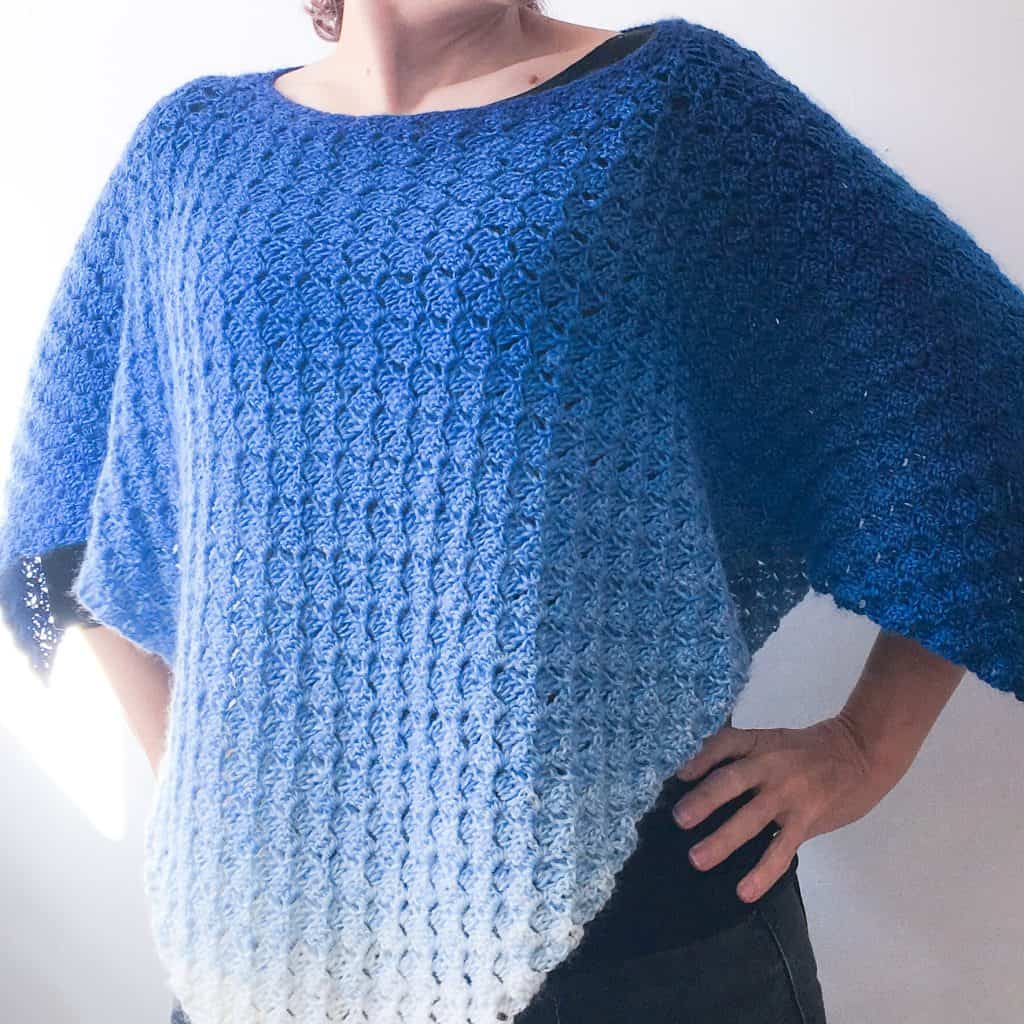
16. Oversized chevron two cake shawl
I love how striking the chevron stripes are in this shawl. It’s almost blanket shawl size and I am absolutely here for oversized crochet shawls at the moment.
The high contrast colourway of these self striping yarns mixed with the zig zag effect creates an absolute wow factor. Subtle it is not, beautiful it is!
- Pattern name & Designer: Disha Crochet Shawl from Knitter Knotter
- Yarn style used: Multiple self striping yarn cakes with a mix of gradual and immediate colour changes
- Yarn details: Scheepjes Whirl in Passion and Whirlette in Rose
- Pattern status: Free on blog with Paid PDF available

17. Rainbow chevron self striping wrap
Everybody loves a rainbow right. And that is true in crochet land as well!
Another chevron pattern here, this time in a rectangular wrap with shorter colour changes, but still long enough to create a self striping effect rather than a pooled one.
This wrap just fills me with joy and I imagine it was a super relaxing make too.
- Pattern name & Designer: Crochet Ripple Prayer Shawl from Crafting each day
- Yarn style used: Aran weight with long, gradual colour changes achieved by mixing plys
- Yarn details: Sirdar Jewelspun Aran yarn in Daybreak Delta
- Pattern status: Free crochet pattern online

Crochet clothing using multicoloured yarn
Self striping yarns with mid-range colour changes would be the obvious go to four garments as stripes always look great. But I’ve taken a different tack here.
I’ve highlighted some top down garment patterns here, because I want to illustrate how they can work successfully with multicoloured yarns.
18. Top down lightly variegated halter top
This top is the one that uses the same hand dyed yarn as the Expansion scarf I talked about earlier.
You can see that over a different area and shape, the yarn works up quite differently. There is an interesting point where it pools heavily just under the bust – which I think is a result of the construction and fastening off and rejoining yarn as the yoke was split because it has a keyhole back.
But most of the body, even where there are increases and decreases have a nicely distributed colour splash.
- Pattern name & Designer: The Corona Halter top from Dora Does
- Yarn style used: Hand dyed flash and speckles sock yarn
- Yarn details: 4ply sock yarn from Unbelievawool
- Pattern status: Paid PDF in 7 sizes
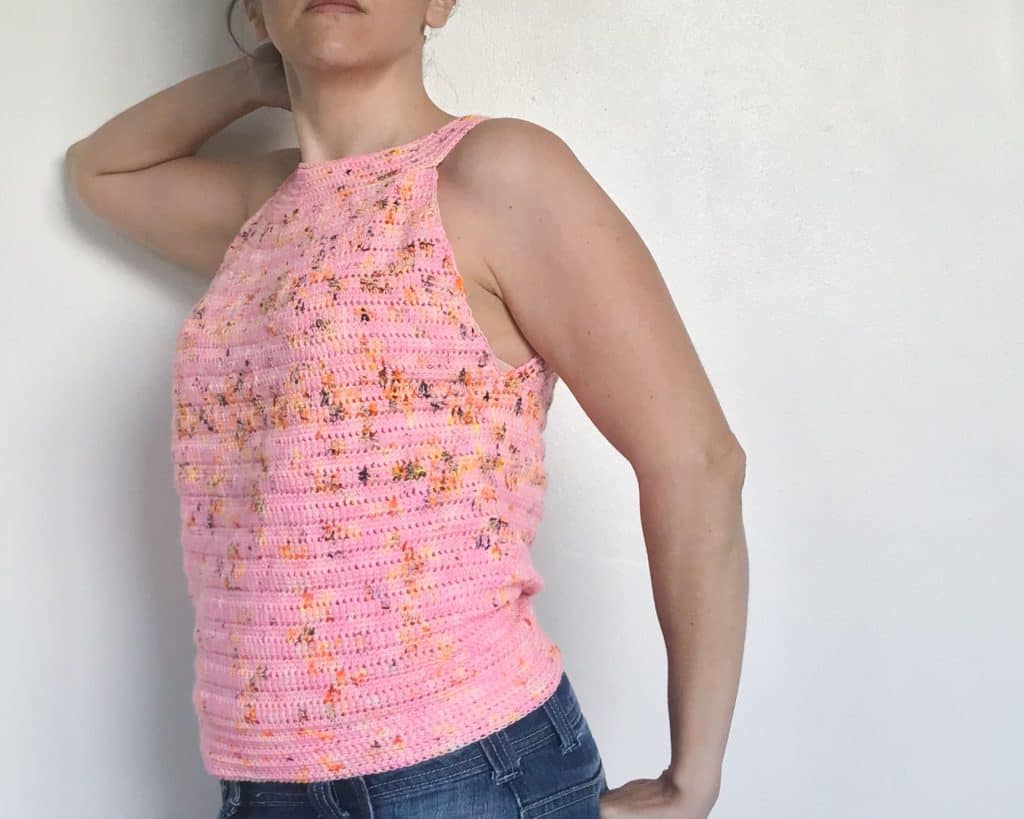
19. Graduated crochet poncho dress
This dress is also crocheted top down, this time using a graduated yarn. The chain the designer chose is a great choice for this design because it is a smaller size ball rather thana huge cake.
This is a great way to use ombré yarns in garments. The smaller balls make more repeats so pattern matching, were you to add sleeves for example, would be easier.
- Pattern name & Designer: Crochet Poncho dress from Willmade
- Yarn style used: Multiple balls of graduated ombré yarn
- Yarn details: Lionbrand scarfie
- Pattern status: Free on the blog

Crochet blanket patterns made using variegated yarn
Moving into the home section of the round up, we’ll start with blankets.
There really are tons of blanket styles you can crochet with variegated yarns. There’s a similarity in approach to the shawl and wrap patterns
I’ve just included two crochet blanket patterns in this round up. Both of these are the less obvious choices because I want to show you something you haven’t already seen lots of.
20. Chevron stripe sock weight blanket
I fell in love with this blanket pattern when I saw it whilst browsing on Etsy. It feels really original and a modern take on some of the classic crochet techniques.
The sample is pictured in fingering weight sock yarn, with each stripe using one ball… it’s quite an achievement. But if you’re not quite that committed, you could also make this blanket with a heavier yarn weight to achieve a similar effect, but on a zoomed in scale.
This one is also a great way to use up stash, mini skeins and maybe some of those advent yarns?
- Pattern name & Designer: Superfine sampler crochet blanket from The Hat and I crochet
- Yarn style used: Multiple graduated and variegated sock skeins
- Yarn details:
- Pattern status:
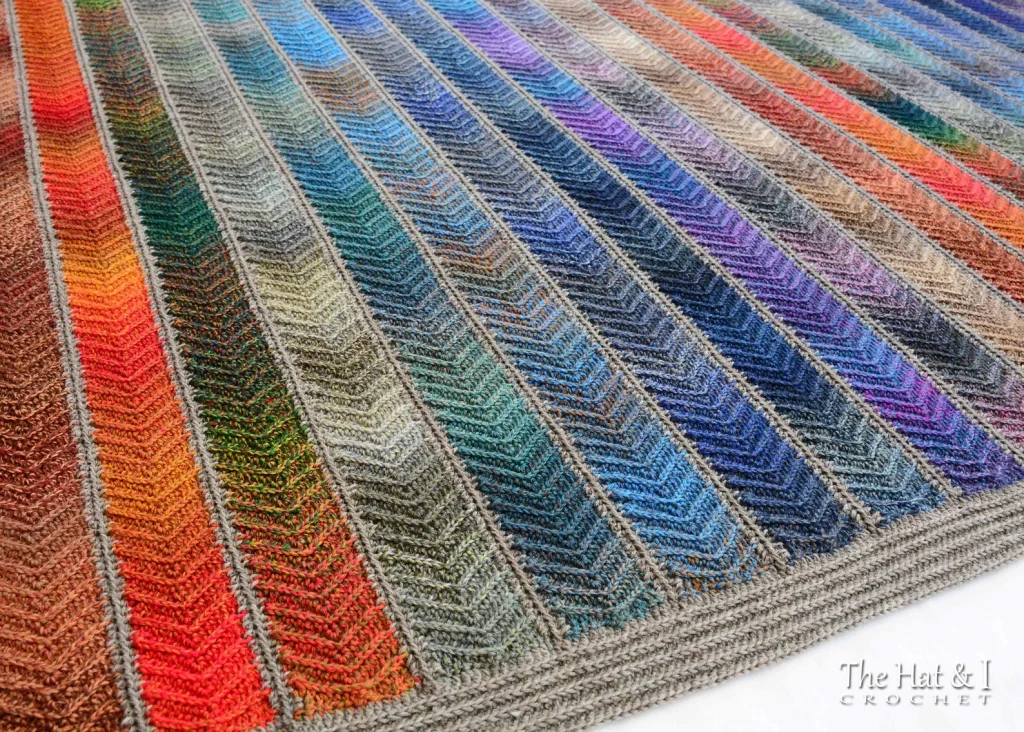
21. Highly variegated tweed effect blanket
This blanket takes a very highly variegated yarn, but with low contrast between the colours and uses a simple, pretty textured stitch to create an almost tweed effect.
It’s a great combination of colour and stitch that creates a unique piece. I don’t know about yo, but I would be delighted to curl up under that!
- Pattern name & Designer: Simple textured crochet blanket from Jewels and Jones
- Yarn style used: A heavily variegated almost tweed like double knit cotton blend
- Yarn details: Lion Brand Comfy Cotton Yarn in shade Chai Latte
- Pattern status: Free pattern on blog

Crochet bag patterns and colour mixing
I’ve seen more and more practical crochet bag pattern designs being released lately and they make a great project to play with colour on. I’ve chosen some quite simple patterns here, but I think with a bag you can really go for it and get out of your colour comfort zone.
Rules are, there ain’t no rules!
22. Small variegated drawstring pouch
I wanted to share this super small crochet bag to show how colour changing yarns can also look super cute on the smallest of projects.
This is quite a heavily variegated yarn but on a small scale it looks different. The small size of the bag means you can get away with a super busy pattern too. Like conecntrate!
- Pattern name & Designer: Small favour bag from Dora Does
- Yarn style used: Short, distinct colour changes which create a flashing stule of zig zag pooling over this small area
- Yarn details: James C Brett Cotton on (discontinued sadly!)
- Pattern status: Free crochet pattern with tutorial

23. Rainbow self striping tote
Different yarn, more rainbows!
This yarn is self striping with semi-solid colours and this tote bag pattern shows it off beautifully. The simple stitches in this one really let the colours in the yarn do the talking.
The stripe depth is really well matched to the length of the colour changes too. I think this yarn would look great in a scarf or shawl as well.
- Pattern name & Designer: Sherbet Stripes Tote from Moogly
- Yarn style used: A lovely self striping yarn with semi-solid colours throughout
- Yarn details: Red Heart Roll With It Tweed in Modern Pastel
- Pattern status: Free pattern

Crochet pillows or cushions using variegated yarn
Pillows and cushions can work beautifully using variegated yarns. My preference would be self striping, speckled or irregular flashes of colour like in the pattern below.
24. Colourwork, speckled crochet pillow pattern
Last but not least, I bring you the Bisou cushion pattern. (Bisou means kiss in french).
This mixes multi-colour Pima cotton yarn with a solid colour mohair. I love mixing fibres in this way. The print is called hand painted sprinkle and I think that describes it perfectly.
A lovely combination of colours which work well together, distributed evenly, but irregularly throughout the fabric (which uses a basic single crochet throughout). I’m ready to give this one a cuddle.
- Pattern name & Designer: Bisou pillow from Dora Does
- Yarn style used: A solid yarn with heavily variegated sections of colour splashes and sprinkles
- Yarn details: We are knitters Pima cotton hand painted sprinkle
- Pattern status: Paid pdf

And with kisses, that seems like a good place to sign off.
I do hope you have found this, somewhat epic, post useful and that you see multicoloured yarn in a whole new, excitingly creative way!
If you have any questions or suggestions about crocheting with multicoloured yarn, please do feel free to drop them in the comments.
Happy Hooking
Dx




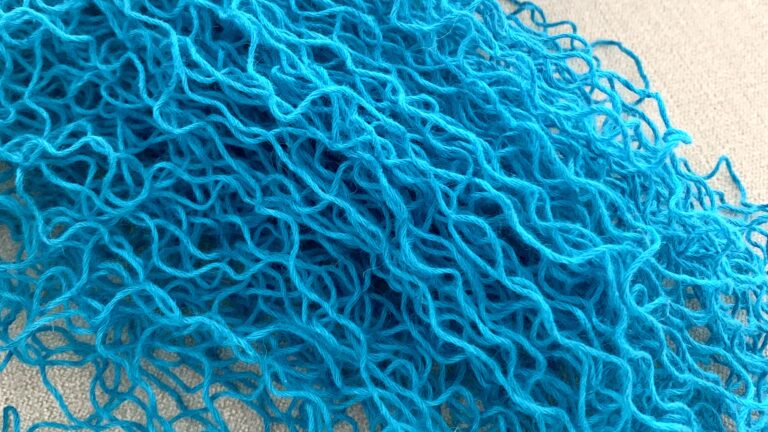


how and where do can I get pooling yarn?
This will depend where you live and where you buy your yarn. The wool kitchen is a wonderful uk based indie dyer, but if you do an internet search for assigned pooling yarn, zip yarn or planned pooling yearn, you will find a range.
Hi Dora,
I love your in depth look at variegated yarns!! I have recently added some variegated yarn in my online store and I would love to link to this article to help buyers out with purchasing. Please feel free to link back to me if you like what you see 😊
Thanks, I’m glad you found it helpful 🙂